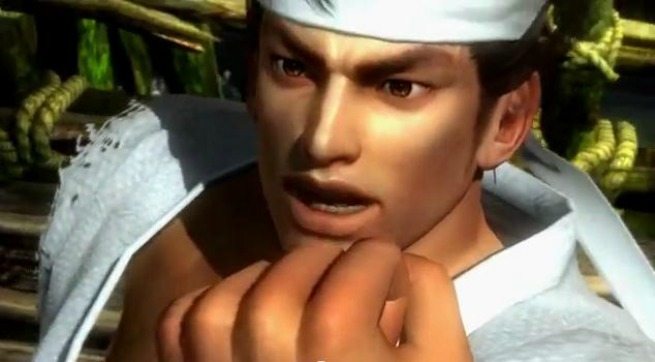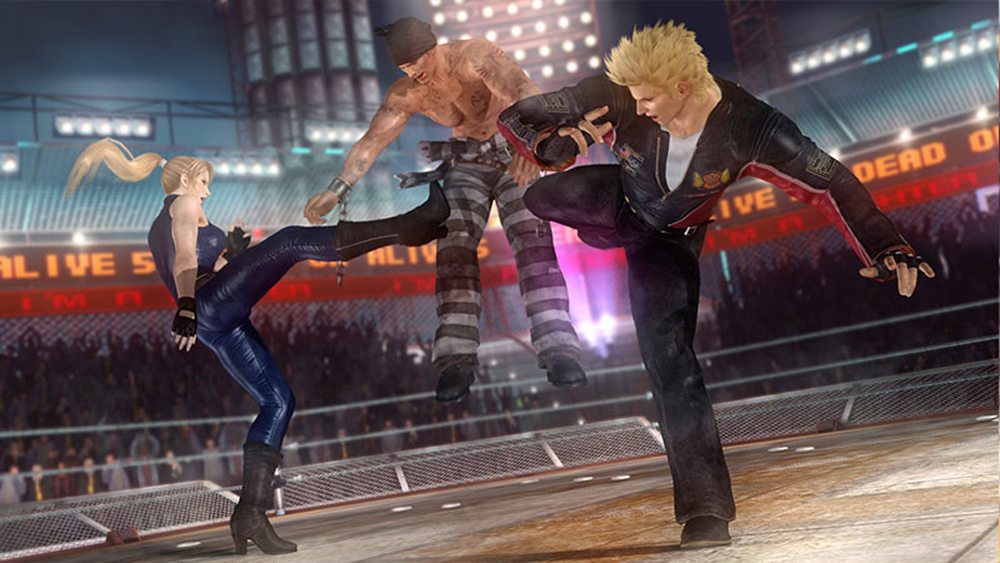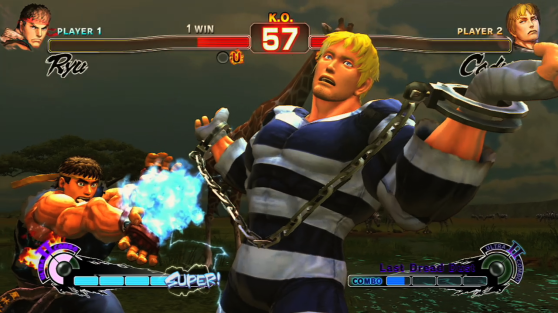GamesBeat: One of the cool features Dead or Alive 5 introduced to the franchise was an appearance by Virtua Fighter characters. How hands on were the AM2 staff with Dead or Alive 5?
Shimbori: We had the Virtua Fighter developers from Sega check everything: the look and animation of the characters, how the control inputs felt, minute details of the behavior after a hit, etc. We had them check everything we put in the game, and they could tell instantly things like the sound of a strike swing being off.
Here’s an interesting story I haven’t shared with anyone yet. In their reviews, the Sega person in charge of checking would practice all the combos. He would ask us to fix combos that connected in Virtua Fighter but weren’t connecting in Dead or Alive, and it also looked like he was having a lot of fun pulling off combos that only connected in Dead or Alive.
We had a rule from Dead or Alive 4 which forced a juggle to end if the player input the same command twice in a row, but we wound up changing that rule. Virtua Fighter characters use P, P, P… as a base for combos.
We weren’t talking about just two of the same command; we’re talking 4 in a row. So thinking about giving players more freedom in their combos, we decided to revert our rule to what had been in use through Dead or Alive 3: the same command doesn’t necessarily end the juggle. It’s simpler to juggle by using the same command rather than figuring out how to string together different moves, so novice players will find it easier to juggle their opponents.
GamesBeat: Although Yu Suzuki isn’t officially with AM2 anymore, Virtua Fighter is definitely one of his babies. Did he have any input on the Dead or Alive 5 project?
Yosuke Hayashi: He told me when we did an interview together that “We pursued the path of fighting simulation for Virtua Fighter. The starting point for Dead or Alive might be the same, but in the course of the series has shifted towards entertainment. I like it.”
That reaffirmed our conviction that we were taking Dead or Alive 5 in the right direction.
GamesBeat: Were there any challenges transitioning the Virtua Fighter characters to the Dead or Alive 5 system?
Shimbori: There were a few. One challenge was dealing with things that Virtua Fighter has but Dead or Alive doesn’t, like evasion, spin attacks, and special low attacks. Other points are moves that are not in Virtua Fighter but which play an essential role in combat in Dead or Alive 5, such as holds and low throws. I wound up thinking up moves for aspects that were missing.
We also implemented small changes when a strike hits. This is really detailed, but for example, ↓P can be blocked with a standing guard in Virtua Fighter 5, but not in Dead or Alive 5, so the move is stronger in Dead or Alive.
Then you have things like the little differences in the concept of frame advantage. It shouldn’t be that Virtua Fighter characters can guard against some moves but Dead or Alive characters can’t, so we balanced them as guest characters appearing in Dead or Alive 5.
There were certainly challenges along the way, but it seems that people are enjoying the Virtua Fighter characters since you see Virtua Fighter characters being used in Dead or Alive tournaments. That makes me happy. I think Dead or Alive and Virtua Fighter go well together, and it’s an honor to have made it happen.
GamesBeat: Fighting games seem to be in an era where extreme “comeback” mechanics have become obligatory. Meter-based moves that build as a player does well is one thing, but we’re increasingly seeing supermoves that reward bad play.
Street Fighter IV’s “Ultra” system is an obvious example, where if a player takes enough damage, they wind up with a big powerful move. Dead or Alive 5 seems to have its own with the “Power Blow,” which gives players a high damage move if they lose 50 percent of their health. Why are fighting game designers adding these mechanics?
Shimbori: That’s an interesting question. This is the first time anyone has asked that.
So why has everyone come to similar conclusions … I don’t know what other designers think, but for me, I think it is because I try to design games that go along with human instinct.
For example, say you were just walking and someone came along in the other direction and ran into your shoulder. Wouldn’t you get mad and want to do the same think to him? I would. I think a lot of people who make fighting games have that kind of personality. At first, it was probably a pretty simple thought, something like, “People would feel a lot better if there were a simple ‘revenge button’. And make it look cool too.”
However, just making a move that is invulnerable, does a lot of damage, looks cool, and can only be used once is very simple game design. It wouldn’t be exciting, and players would get mad at the system itself if an enemy did that move to them.
Not only that, but an invulnerable move that is too easy to pull off will cause people to hold back their own attacks, forcing them when it’s time to finish their opponent to stop and watch what the opponent does. Power Blows exist in their current form because I felt it would be wrong to frustrate the winning player. That goes against what our priorities should be.
Just in case you missed it, be sure to check out part one of this interview, where we discuss Team Ninja’s intent with Dead or Alive 5: Last Round, their viewpoint on the sexuality debate, and potential future projects.
VentureBeat's mission is to be a digital town square for technical decision-makers to gain knowledge about transformative enterprise technology and transact. Learn More




